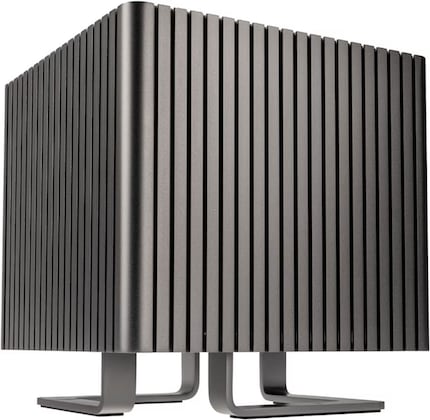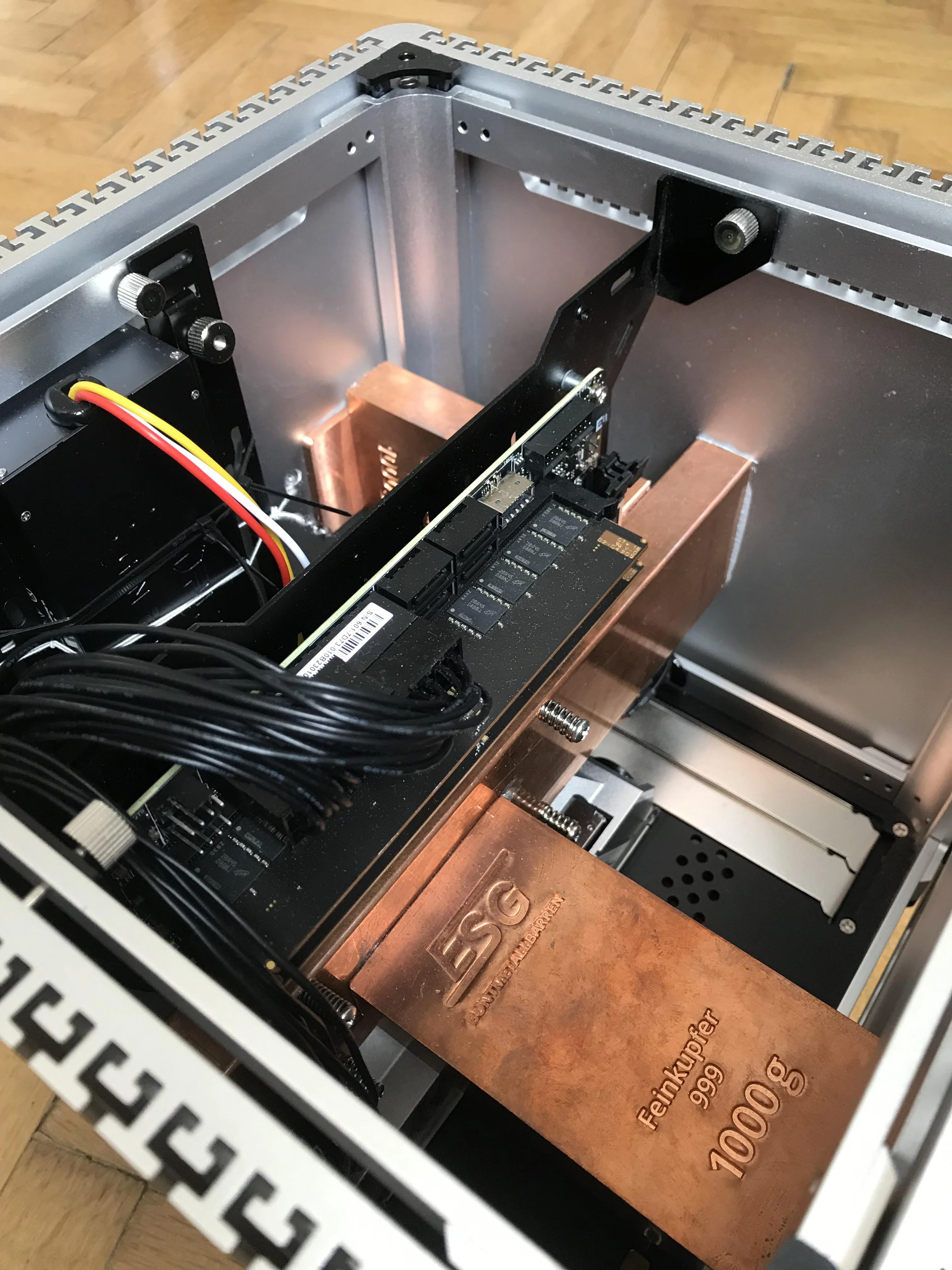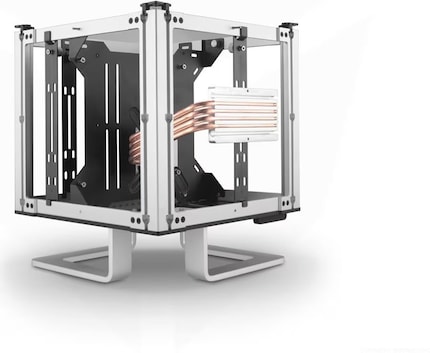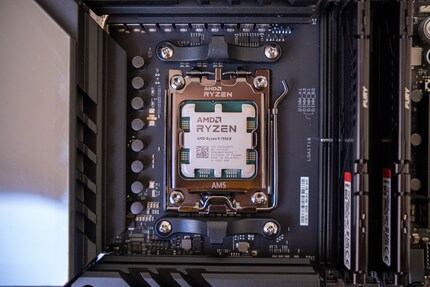
Background information
The freezer PC: «We want to cool the CPU to a constant 20 degrees Celsius»
by Kevin Hofer

An editor cools his CPU passively with copper blocks weighing over four kilograms. I take the opportunity for a thought experiment and confront a demon from my past.
Tech portals around the world have picked up the post by Redditor AromaticImpress7778. In it, he shows his DIY cooling system: A total of 4.4 kilograms (kg) of copper cool his 7950X processor passively - i.e. without a fan. Under load, the CPU heats up to 95 degrees Celsius and runs at 90 per cent of maximum performance. It achieves all this in the DB4 mini ITX case from Streacom. This emits heat via the fins of its casing. The external temperature of the housing is thus between 50 and 60 degrees Celsius.

I find the cooling system impressive. I want to know how long it takes for the case to reach 60 degrees Celsius with average use of the Redditor. Why is that? Simply because it interests me and I find it an exciting thought experiment. Is it scientific now? Hardly. More like reading coffee grounds paired with a bit of maths and physics.

To find out, I have to face my demon: maths. I finished secondary school with a 2.5 - which is equivalent to a 5+ in Germany. So I'm at about the maths level of a ninth grader.
Luckily, Google exists today. I quickly find the two formulas I need:
t=Q/P
Q=mcΔT
t is the heating time in seconds, i.e. what I want to find out. I need the other variables to work it out. So it's maths. Q stands for the energy required to change the temperature of a certain body by the amount ΔT - the so-called thermal energy. I still need to calculate this using the second formula. P is the heat output in kilowatts (kW). m in turn represents the weight and c the specific heat capacity of the material. ΔT stands for the temperature change of the material.
Is your head spinning already? Mine has leaked a lot of gas. I still don't know if I really understand it all. Exactly: I'm a zero in maths.
So much for the theory. Now I just have to find the correct values. From here, the accuracy goes downhill. I can't clearly determine many of the variables. At least the weight of the copper is quickly clarified because AromaticImpress7778 gives the answer itself: 4.4 kg. As the copper is connected to the housing and therefore to the aluminium, I also have to include this. The housing weighs 7.5 kg in total. According to the manufacturer, almost the entire housing construction is made of aluminium, except for some acrylic glass and steel. I therefore reckon with seven kg.

The specific heat capacity is a material constant. It indicates how much heat energy a kg of a certain building material must absorb in order for its temperature to rise by one Kelvin (K). The higher this value, the slower a material heats up. The specific heat capacity of copper is 390 J/kg°K. Only silver has an even lower heat capacity among metals. I was aware of this, but now I can also explain why copper is ideal for cooling. The aluminium of the housing has a heat capacity of 900 J/kg°K.
The ΔT is more difficult to determine. The CPU heats up to 95 degrees Celsius. However, the same does not apply to the copper parts. Here, the heat is distributed over the entire volume and also the housing shell to which the blocks are connected. Fortunately, AromaticImpress7778 provides a value for the casing of the DB4 housing. This becomes 50 to 60 degrees Celsius hot. The housing is designed in such a way that the heat is dissipated via the fins of the aluminium housing and by the natural air circulation in the room. I therefore assume a temperature of 60 degrees Celsius for the copper. To arrive at ΔT, I have to subtract the room temperature, which I assume to be the initial temperature. I assume 20 degrees here. ΔT therefore corresponds to 40 degrees. As I said, it's not quite so correct here. But as a rough assumption, I think it will be correct.

The last thing is the heating power. This is probably the least accurate. I only know the approximate power of the CPU. Some power will always be lost at the contacts between the CPU and the copper blocks and later the housing. I don't know how much. I therefore take the average values of the CPU. AromaticImpress7778 also writes in his post what he needs the CPU for and what his workflow looks like. He mainly programmes. He compiles for around one minute every ten minutes. During this time, the CPU is running at its maximum. It's difficult to say how much power it needs then. In my review of the CPU, it was up to 230 watts (W). Since the editor cools his system without a fan, I assume less and use the maximum thermal power dissipation specified by AMD: 170 W. However, this value is only valid for one out of ten minutes. The rest of the time, the CPU will probably draw around 60 W, as I measured in my review. I therefore assume a heating power of around 0.08 kW in the case of AromaticImpress7778. Yes, I know: that's a lot of assumptions. But it's enough for a thought experiment.
If I insert the determined values into my first formula, the result is 68,640 J of thermal energy for copper and 252,000 J for aluminium. Together, this results in 320,640 J and 320.64 kilojoules (kJ) of heat energy respectively.
Now I just have to divide the thermal energy by the heat output. 320.64 / 0.08 equals 4008 seconds or 66 minutes and 48 seconds. It therefore takes just over an hour for the Redditor's PC to stabilise at the final temperature with average use. That's an impressive result for a completely fanless case. I wouldn't have expected it to take that long. Even if the system was constantly running under full load, it would take just over 31 minutes to get this hot. In this case, however, it can be assumed that this is not the end and the casing will get even warmer.
Of course, my thought experiment is not watertight. Too many things are unknown or simply not precise enough. Other factors, such as the closed housing, will also have an influence. In reality, the outside temperature of the housing is probably reached much faster and higher temperatures prevail inside.
I still had fun working this out. If I've made a mistake, let me know in the comments column. As I said, I'm no maths whizz. If you think the maths is completely rubbish: That makes two of us. But I like it absurd.
Header image: Reddit / AromaticImpress7778From big data to big brother, Cyborgs to Sci-Fi. All aspects of technology and society fascinate me.